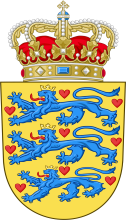Denmark: Government
Key Figures
- Chief of State:
- King Frederik
- Head of Government:
- Prime Minister Mette Frederiksen
Overview
- Government Name:
- Kingdom of Denmark
- Constitution:
- Adopted: 1953; the main principle of this Constitution was to limit the monarch's power. Additionally, it separates governmental powers into three branches influenced heavily by French philosopher Montesquieu who aimed to achieve mutual monitoring of each of the branches of government through the separation of powers.
- Government Type:
- Constitutional Monarchy

Index of Economic Freedom
Country Risk Rating
Government Branches
| Main Powers | Election Process | Election Cycle 1 | |
|---|---|---|---|
| Executive | The queen is theoretically the source of all executive and legislative power, but a de facto separation of powers has been in effect since the introduction of parliamentary sovereignty. The prime minister presides over the cabinet, but only has power and authority given to them by the monarch. |
The monarch is hereditary, and the prime minister is appointed by the monarch. |
Until dismissal by the executive branch |
| Judicial | The supreme court functions as a civil and appellate court for cases from subordinate courts. Its judgments cannot be appealed to another Danish court, however, it does not deal with the issue of guilt. |
Judges are appointed by the monarch upon the recommendation of the minister of justice with the advice of the judicial appointments council. |
No term limit, mandatory retirement at age 70 |
| Legislative | The Folketinget is the parliament of Denmark. It is the supreme and ultimate legislative body while operating within the confines of the constitution. Parliament may question ministers regarding specific government policy matters. |
The Folketinget members are elected by open-list proportional representation in multi-member constituencies based upon the three electoral regions in Denmark. 17 multi-member constituencies are divided among these regions. |
4 years |
Regional Trade Blocs
International Organization Participation [2]
Environmental Agreements [3]
Tax Information [2]
- Tax Authority:
- Central Customs and Tax Administration
- Tax Name:
- VAT
Sources:
- ElectionGuide http://www.electionguide.org/
- EY, http://www.ey.com
- CIA World Factbook, https://www.cia.gov/the-world-factbook/
- U.S. Bilateral Relations Fact Sheets http://www.state.gov/r/pa/ei/bgn/


